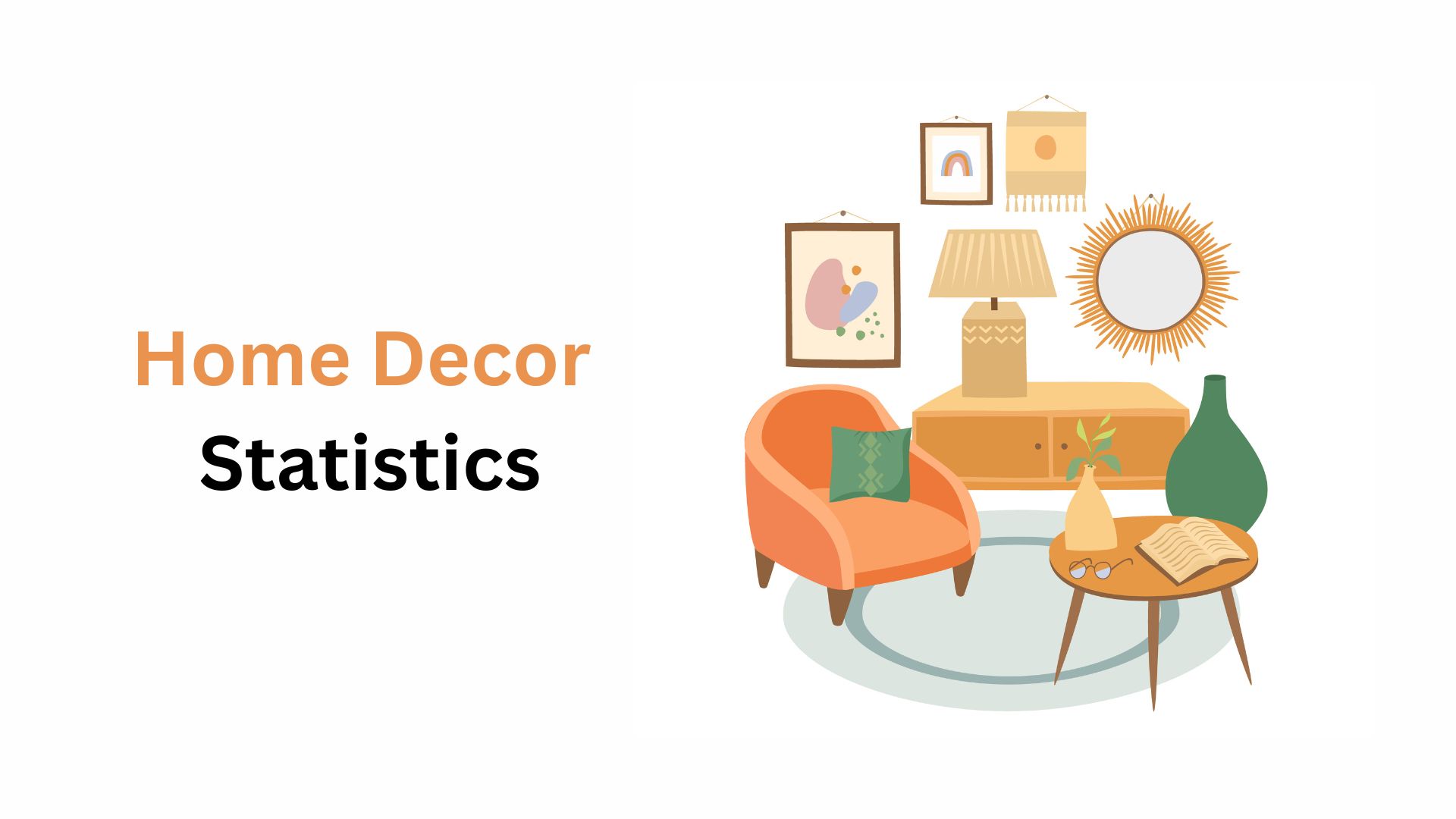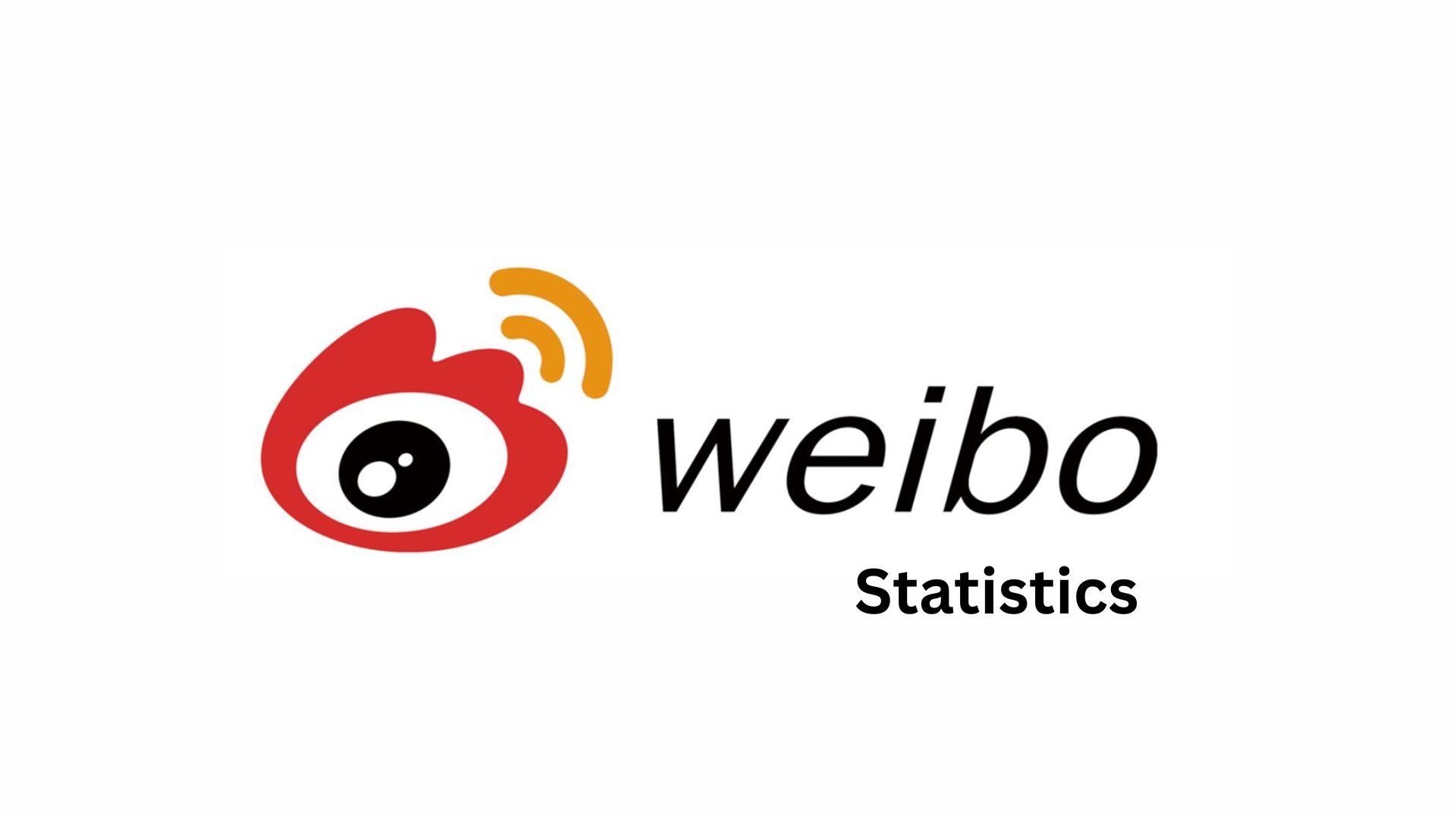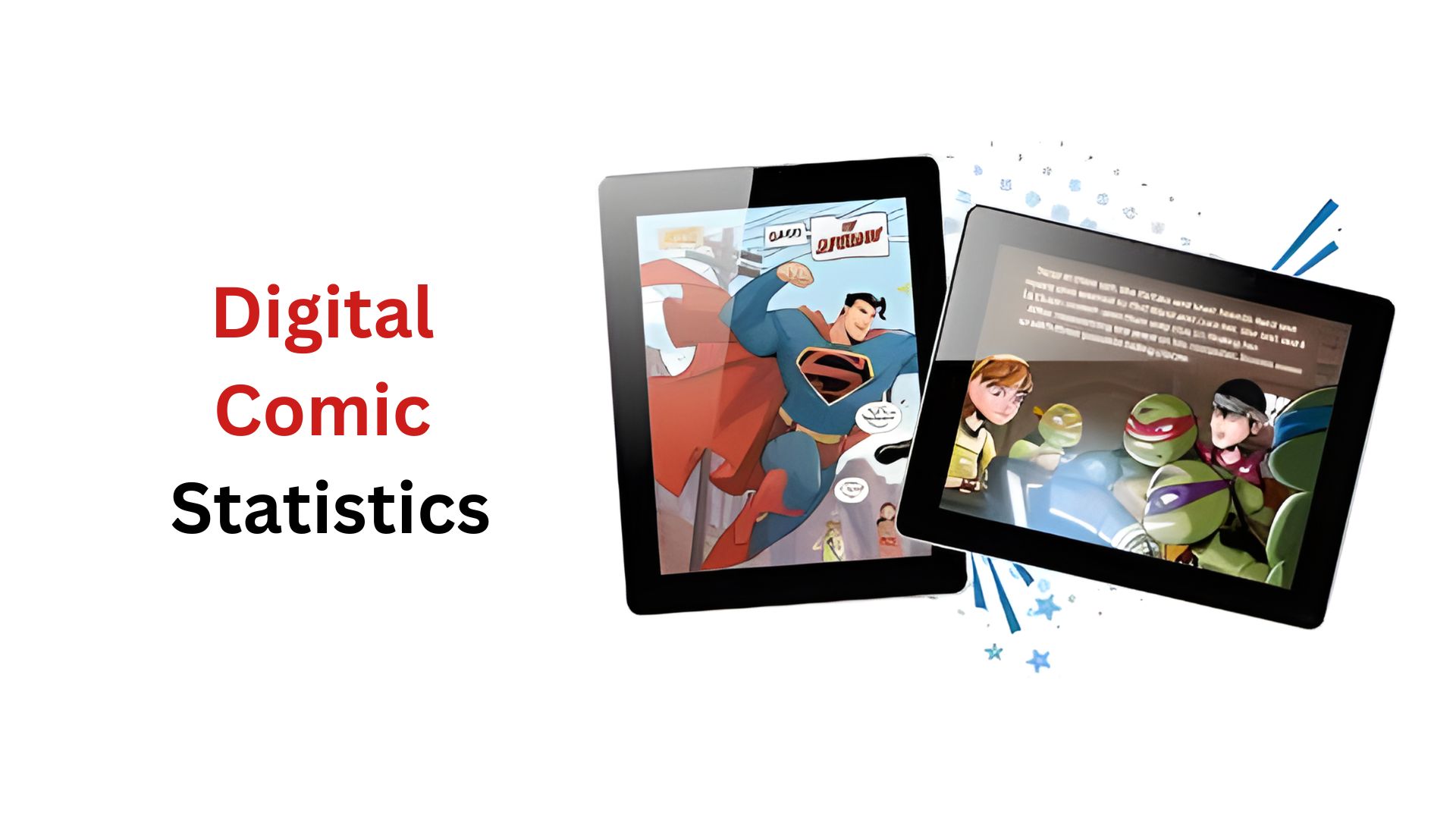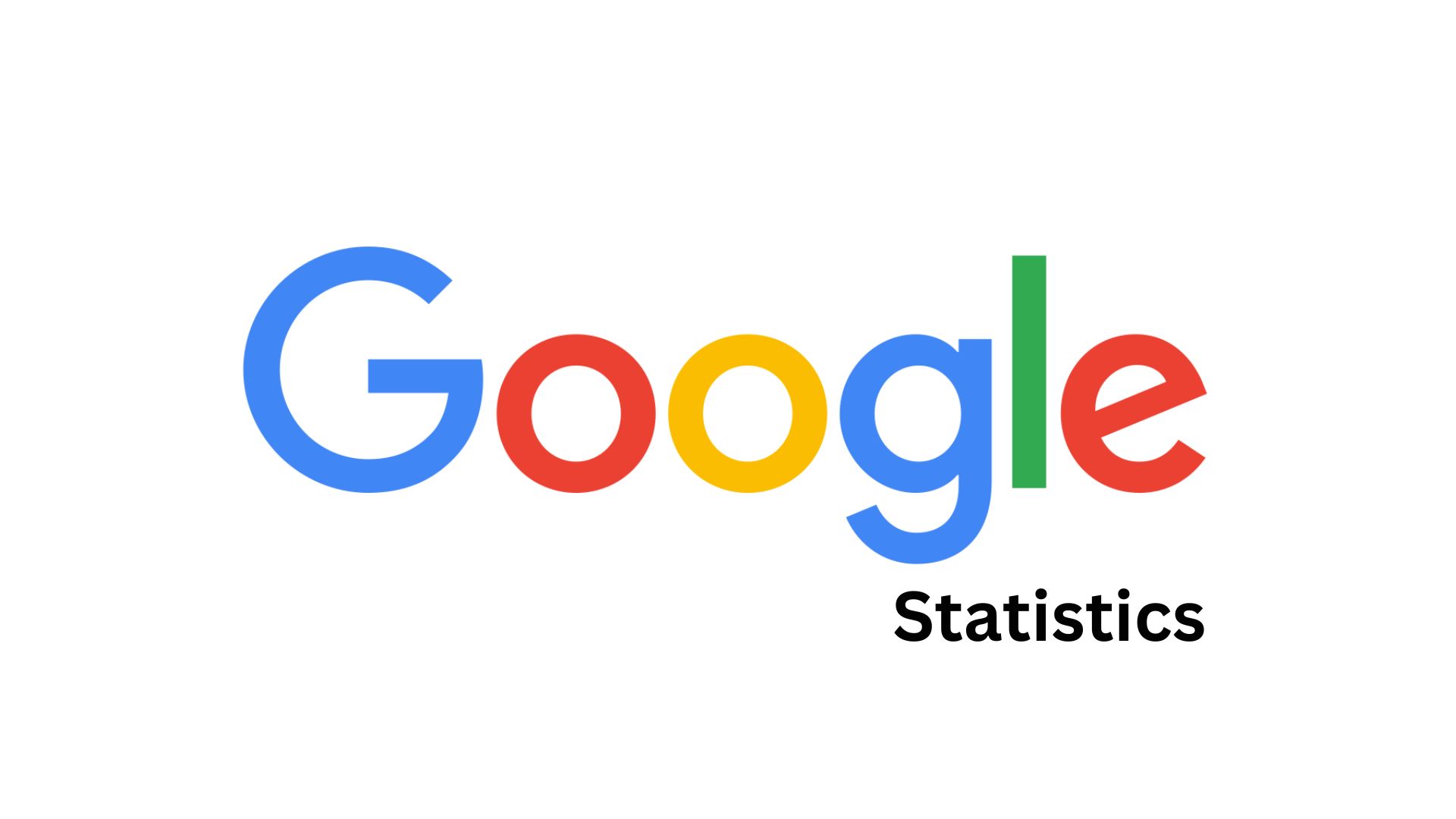Small Business Online Marketing Statistics And Facts (2025)
Updated · Jul 22, 2025
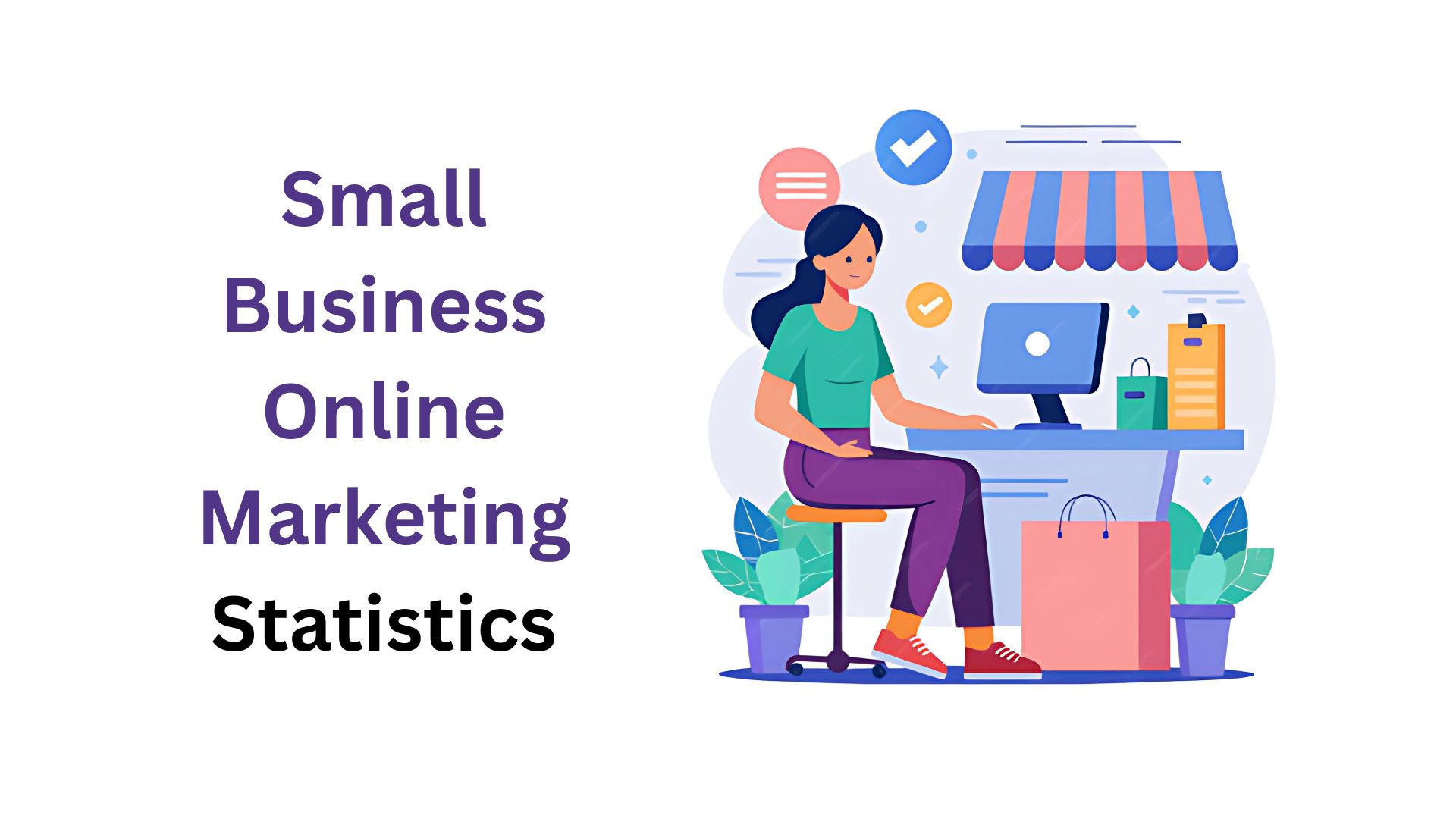
Table of Contents
- Introduction
- Editor’s Choice
- The Topmost Influential Market Channels For Business
- Number of People Dedicated To Marketing In Business
- Small Business Budget For Online Marketing
- Small Business Advertising Statistics
- Small Business Reputation Management And Online Presence
- Different Generations Discover And Support Local Small Businesses
- Small Businesses Market During The Holiday Season
- Conclusion
Introduction
Small Business Online Marketing Statistics: For the year 2024, there was a continued shift for small businesses to pour money into online marketing efforts encompassing websites, social media, SEO, emails, and content strategies. Digital marketing is what could go from being the best thing to touch smaller firms if they wish to remain competitive in an overcrowded marketplace.
According to recent studies, 58 to 60% of small businesses have embraced digital marketing, with 73% setting up a website and 96% engaging in social media promotion for their products or services.
Coming up ahead, let us look into some key small business online marketing statistics, success rates, budgets, methods, and outcomes in 2024, all supported by data and industry sources.
Editor’s Choice
- Over 58-60% of small companies were active digitally in 2024, more than 73% had websites, and 96% trying to push social media.
- Customer reviews, word-of-mouth referrals, and influencer or celebrity endorsements have been the top three marketing tactics for small businesses.
- The small businesses only managed or influenced 43.5 per cent of customer reviews, which can be hugely important.
- Those organisations with more than ten marketing staff were 75 per cent confident about their ROI, whereas those without any marketing staff had only six per cent confidence in their ROI.
- 44% of small businesses spend 6–10% of their entire budget on marketing, with 63% anticipating a budget increase in the coming year.
- 65% of consumers are influenced by search ads to make a purchase, while currently, only 40% of small businesses implement them.
- 84% of small businesses doing PPC report positivity, at an average cost of $4.66 per click.
- As far as ROI, 49% of small businesses said the best comes from organic search.
- Consumers aged 18 to 54 rely mostly on social media and search engines when it comes to locating local businesses. On the flip side, those aged 55 and above lean toward flyers and direct mail.
- 66% of Gen Zers find local businesses through social media, compared with only 37% who use search engines.
- Gen X and millennials constitute higher proportions of shopping through small businesses.
- 92% of holiday shoppers will make their seasonal spending with small businesses.
- 79% of consumers plan to shop at small businesses that they have never shopped at before.
- 51% of small and medium businesses deem social media and email marketing to be most effective around the holidays.
- One-third of small businesses do not run any holiday promotions, even though 35% say discounts and sales work best.
The Topmost Influential Market Channels For Business
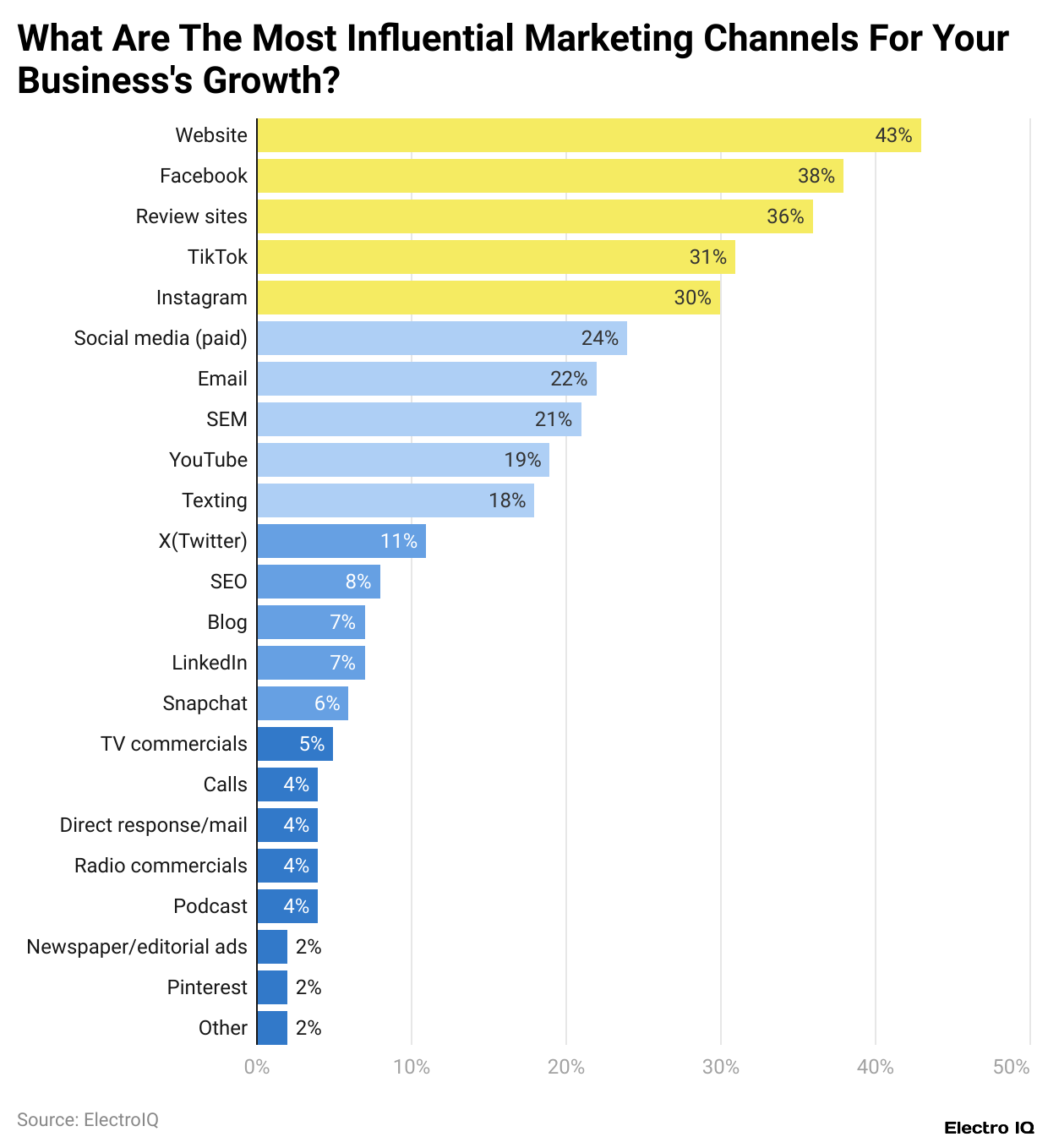
(Reference: simpletexting.com)
- The three most influential marketing tactics selected by small business owners are customer reviews, word-of-mouth referrals, and influencer or celebrity endorsements, with the most influential of them all being customer reviews on platforms such as Google, Facebook, and Amazon.
- However, only about 43.5% of small businesses actively try to influence or manage their reviews. Again, here’s a disconnect between what they feel is important and what they do about it, the reason behind a major growth opportunity.
- Small businesses can really make an impact if this changes through the encouragement of satisfied customers to put up favourable reviews and overseeing those who need assistance.
- Appropriately addressing reviews further converges on the factors of strengthening its online reputation, somewhat building credibility in its target audiences’ eyes, and attracting new customers.
- Next in marketing importance are the influencers and endorsements; working with TikTok influencers that represent the brand image can be fun and rewarding since it allows for the creation of creative viral videos targeting a younger crowd. This form of marketing, apart from just giving performance marketing, assists in brand awareness on a more relational level. Instagram is also a great platform for influencer marketing.
- Small businesses entertain their audiences live through Stories, IGTV, and Reels, lately riding on trends.
- Team up with influencers on these platforms to give small businesses access to existing follower bases, providing rapid and effective expansion of their reach.
Number of People Dedicated To Marketing In Business

(Source: simpletexting.com)
- A marketing team in a small company has a strong bearing, one way or the other, on how successful marketing efforts prove to be.
- Usually, small companies resort to three to five people for marketing purposes. The willingness that marketing activities can yield a positive ROI increases with the size of the marketing team.
- For instance, 75% of businesses with a minimum of 10 marketing employees believe that their marketing initiatives will provide good ROI, while just 30% of firms with only one marketing employee admit to that feeling.
- For the 6% of the companies that have no set marketing personnel and who are confident about the ROI, the difference is striking. This, therefore, suggests that the larger the marketing team that focuses on marketing activities, the more they deliver in marketing effects, while confidence on the side of the owners is also greatly enhanced.
Small Business Budget For Online Marketing
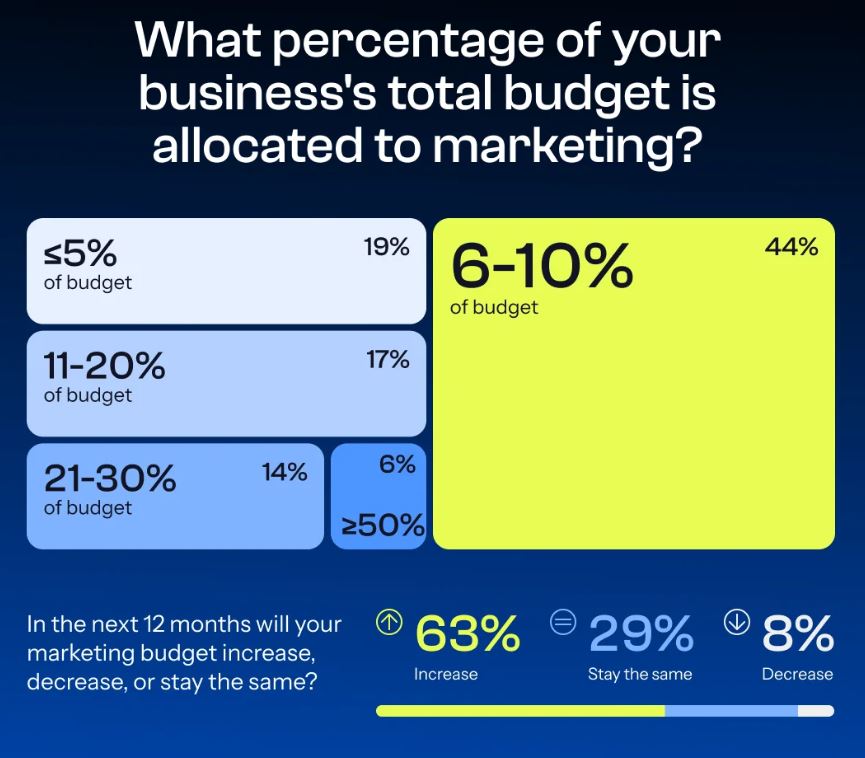
(Source: simpletexting.com)
- Around 44% of businesses spend 6% to 10% of their total budget on marketing. Funding at this level is closely related to better results; indeed, 48% of businesses that spend this much consider themselves successful in their marketing efforts.
- Marketing works less well for companies that invest less, with only 11% reporting good results from marketing activities. Going forward, many small businesses feel inclined to invest heavily in marketing.
- Some 63% say they will increase their marketing budgets in the coming year. Pressure is especially mounting in the technology, human resources, and finance industries.
- 80% of firms in both technology and HR intend to raise marketing expenditures, and 76% of finance firms are about to follow suit. This burgeoning investment highlights the growing importance of marketing in the array of industries.
Small Business Advertising Statistics
- Small businesses using pay-per-click advertising can essentially expand their outreach and trade sales.
- An estimated 65% of consumers are highly inclined to click on a search ad when ready to make a purchase, highlighting the enormous opportunity for PPC in converting potential consumers.
- Yet, just about 40% of small businesses use search ads currently. This implies that many businesses might have been neglecting a major opportunity to increase market presence through some form of effective advertising.
- Given that the average CPC for small businesses running Google Ads is at $4.66, it, of course, proves to be a fairly inexpensive option to draw attention to interested buyers.
- After search ads, 22% of small businesses resort to display ads for another shot at capturing consumers’ attention, especially for those that have yet to venture into visual ad placements. If anything, this only helps.
- Personalisation can be seen in results; PPC campaigns funnelling users to personalised landing pages see an improvement of about 5%, demonstrating how tailoring effects can have a real impact. Overall, 84% of small businesses consider their PPC campaigns to be successful.
Small Business Reputation Management And Online Presence
- The significance for small businesses to have a solid online presence is that it directly affects their credibility and customer confidence.
- Closing in at 49% of business owners who state that organic search yields the highest return on investment (ROI) in marketing, an SEO strategy becomes an absolute must, especially for appearing first on local search results, where it can double front visibility and potentially double foot traffic.
- Customers spend about 50% more with businesses that respond to reviews from customers, no matter if they are positive or negative. This, of course, emphasises the importance of being responsive and genuinely caring in customer interactions.
- About 93% of people read online reviews before deciding to purchase.
- Nearly 84% trust online reviews as much as personal recommendations from friends and family. Purely by building solid credibility, a strong online reputation also provides value.
- Consumers may pay about 22% more for products or services offered by small businesses that carry the name of being well-reputed. The major part is the visibility on search engines.
- Only 25% of users go beyond Google’s first page of search results, meaning that 75% do not. It is surpassingly important to have a high ranking if the business is to be visible to its target audience.
- The trend of voice search is growing, and the average answer length is only 29 words. To compete in voice searches, small businesses need to keep their content very brief and straight to the point. Finally, local searches present a high growth opportunity for small businesses.
- About 46% of all Google searches are by people who want to transact locally. This is evidence that the prospective customers are now searching for what small businesses have to offer, hence the need for adequate SEO and reputation management strategies.
Different Generations Discover And Support Local Small Businesses
- The mass of consumers between 18 and 54 rely most on social media and search engines to locate a local business.
- For those in the range of 25 to 54, flyers are seen as the next best method, coming directly after digital platforms.
- As per Wix and VistaPrint (2024), small business online marketing statistics show that for those 55 and older, however, the decision still largely falls on the old traditional way. This group ranked direct mail and flyers as their top ways for discovering local businesses, thus ensuring that print advertising still holds sway with baby boomers.
- Surprisingly enough, Gen Z appears to be one of the most pro-small-business generations. One study shows that 46% of Gen Z consumers visit a local small business once or twice a week, while 21% are constantly looking for new businesses to patronise.
- Yet it seems that 42% of them find it difficult to locate local small businesses in their area. While Gen Z intuitively appears to show such strong interest, another study actually brings to light the fact that Gen X and millennials shop with small businesses more often than both Gen Z and baby boomers.
- For Gen Z, however, not all digital channels are infinitely effective. Search engines are less popular among 18–24-year-olds than in any other age group.
- Instead, social media leads with a landslide majority of 66% of Gen Z claiming the discovery of new local businesses through social platforms, compared with 37% who prefer search engines.
Small Businesses Market During The Holiday Season
- Of those holiday shoppers, 92% want to support small businesses in their shopping activities. All that big support for them during a pleasant season. For the pre-season of the holiday rush, there are only a few essential considerations for small and medium enterprises.
- Approximately 35% are coming up with measures to increase efficiency, while 28% will provide special promos and discounts, and 26% are strategising clear marketing tactics for a successful season.
- Customer acquisition interests them as well, since 78% of customers state that they intend to shop at a small business they have never purchased from before.
- Even with this, they still do not know how to measure success, since of those who do measure marketing success of SMBs, 79% did not know if their 2023 holiday plan had been a success.
- Meanwhile, about 20% of small businesses state they do not even have any way of measuring the impact of their holiday marketing, yet some 51% consider social media and email marketing to have the greatest impact on their holiday goals.
- There is an increase in marketing activities in the fourth quarter, with some 57% of SMBs increasing the frequency of their communications over the period, while 31% continue at the usual rate.
- Promotions continue to be of utmost importance, as 35% of SMBs considered discounts and sales to be the best holiday strategies.
- Bundle offers, early access, and exclusive deals also generate good results. Surprisingly, one-third of companies had no promotions at all in the holiday season. Small Business Saturday reaches its peak as the huge shopping day of the year.
- Over a third of consumers (34%) intend to shop on November 30 and expect close to 39% of their holiday spending to take place on that day.
- This technology has influenced this season, with 30% of small businesses still using AI tools to launch email campaigns in a targeted manner, personalise customer service, or manage inventory.
- From a consumer perspective, 23% anticipate that they will employ AI to locate holiday deals and help plan their purchases.
Conclusion
Small Business Online Marketing Statistics: In 2024, small businesses were focusing on online marketing to stay on top and invested heavily in websites, social media, SEO, and PPC. Customer reviews, word of mouth, and influencer marketing remained most effective, yet many businesses do not fully embrace search ads and holiday promotions. The increase in budget, size of the team, and the confidence in the ROI were apparent correlates.
Generational trends showed just how much social media is favoured among younger folks. Essentially, having a strong digital presence, reputation management, and marketing strategies, especially during the holidays, mattered for a small business to thrive.
FAQ.
Small businesses, in 2024, considered reviews from customers, word of mouth, and influencer or celebrity endorsements as major marketing methods that affect them. Reviews on sites such as Google and Facebook had a major impact on them; yet, only about 43.5% of businesses worked actively to manage these reviews.
The larger the marketing team in a business, the more confident they were that they would earn a return on investment, and the higher the chances of that return being realised. Businesses reporting confidence of returning on investment stood at 75% with 10 or more marketing people, compared to 30% when there was only one marketer, and 6% where there were none at all.
In 2024, 44% of small businesses spent 6–10% of their budget on marketing, and out of these, 48% saw positive results. On the other hand, only 11% of small businesses allocating less than 5% for marketing recorded success.
There are generational variations in consumer discovery habits: Gen Zs (66%) prefer to use social media to find local businesses, with only 37% using search engines. Gen X and millennials frequent small businesses more than the other groups. The 55+ consumer bunch is said to be more into traditional means like flyers and direct mail.

Maitrayee Dey has a background in Electrical Engineering and has worked in various technical roles before transitioning to writing. Specializing in technology and Artificial Intelligence, she has served as an Academic Research Analyst and Freelance Writer, particularly focusing on education and healthcare in Australia. Maitrayee's lifelong passions for writing and painting led her to pursue a full-time writing career. She is also the creator of a cooking YouTube channel, where she shares her culinary adventures. At Smartphone Thoughts, Maitrayee brings her expertise in technology to provide in-depth smartphone reviews and app-related statistics, making complex topics easy to understand for all readers.


